We are undertaking a field effort off Hawaiʻi Island from October 15th through the 28th. Like many of our Kona field projects, we will be working with a number of different species and have a number of goals. False killer whales are always our highest priority, and we’ll spend time offshore looking for pelagic false killer whales when the weather is really good, as well as inshore looking for insular false killer whales when the weather offshore isn’t quite as good. If we find false killer whales, we hope to deploy LIMPET satellite tags, collect biopsy samples for genetic studies, and get photos to identify individuals.
During the project we’ll also be working with Scott Baker from Oregon State University’s Marine Mammal Institute collecting environmental (e)DNA samples. This effort is funded by the Office of Naval Research, and we’ll be collecting samples from social species such as short-finned pilot whales, pantropical spotted dolphins, spinner dolphins, and hopefully melon-headed whales, as well as more elusive species such as beaked whales and dwarf or pygmy sperm whales. The eDNA samples will be processed by OSU to characterize the population diversity of haplotypes of the social species and determine the species of the elusive species.
We’ll also be working with Russ Andrews from Marine Ecology and Telemetry Research on an effort funded by the Navy’s Living Marine Resources program deploying LIMPET satellite tags on short-finned pilot whales. As usual during our field effort we’ll also be recording information on seabirds and other marine megafauna we encounter, undertaking drone operations with several species of cetaceans, and collecting biopsy samples from some species for studies of genetics, trophic ecology, and pollutant ecology.
The research team will include Colin Cornforth, Jordan Lerma, Shannon Vasquez, Robin Baird, Scott Baker, Russ Andrews, and a number of volunteers.
End of project update

Overall this was a very successful project. In 11 days on the water we encountered 10 species of cetaceans, with 10 encounters with short-finned pilot whales, four encounters with pantropical spotted dolphins, three encounters each with bottlenose dolphins and Cuvier’s beaked whales, two encounters with Blainville’s beaked whales, and one encounter each with melon-headed whales, rough-toothed dolphins, spinner dolphins, dwarf sperm whales, and a humpback whale. We took over 40,000 photos, obtained high-speed video footage of three species, obtained drone photogrammetry images from 10 encounters (of six different species), collected three biopsy samples (all from beaked whales) and 43 eDNA samples (from seven different species), and deployed two satellite tags (on pilot whales). We want to thank the 13 different volunteers we had out with us and individuals who reported sightings!

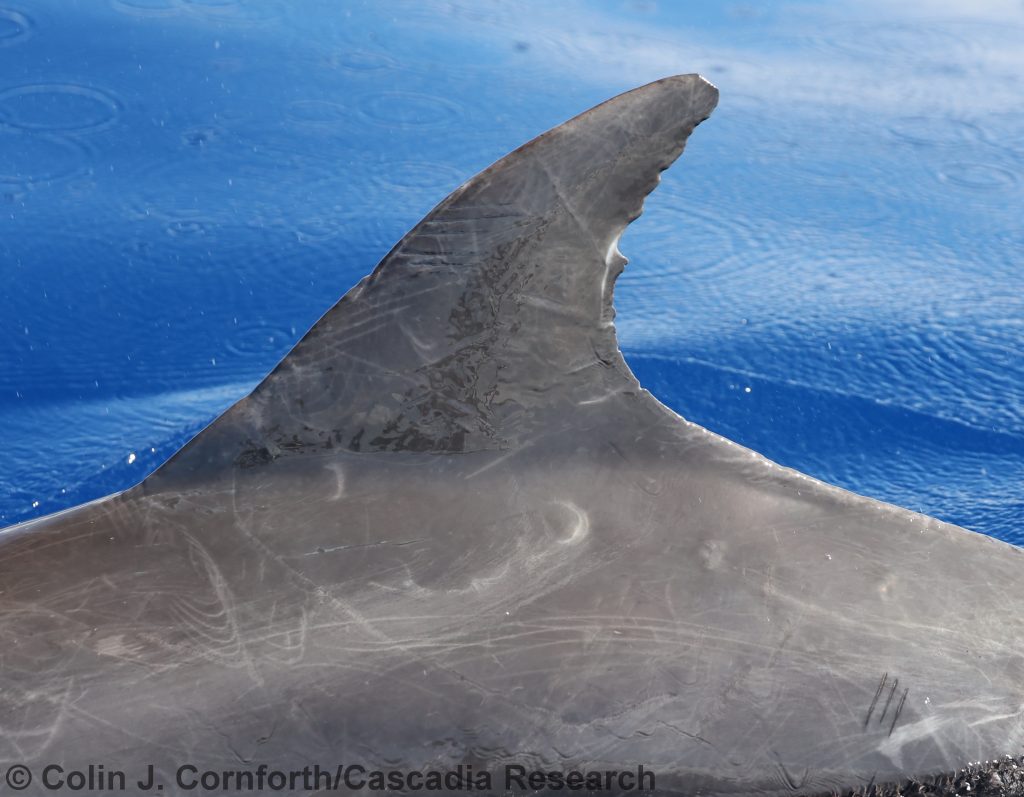
On October 26th we encountered a group of about a dozen bottlenose dolphins. In addition to getting good ID photos of the group we also witnessed the dolphins taking live bait from two different fishing vessels. This type of “depredation” behavior is often reported, but rarely witnessed by researchers.

October 24th update

Today we encountered an interesting jellyfish, likely Thysanostoma loriferum, although we’ve submitted the photo to Jellywatch.org for species confirmation.

We encountered a group of five Cuvier’s beaked whales today – Cuvier’s are among the most anti-social cetaceans in our area – five individuals is the largest group we’ve ever encountered of this species. We were able to get another eDNA sample from the group and good ID photos of at least four of the five. Two of them we were able to quickly match to our catalog – the adult female (on the right) above is HIZc027 in our photo-ID catalog. HIZc027 was first photographed in 2005 and has previously been documented 10 times in eight different years, with the last sighting in 2019. During our last encounter with her in 2019 we actually collected a breath sample using a drone.

We also had a productive encounter with a group of short-finned pilot whales, obtaining drone photogrammetry images of more than a dozen individuals, photo-identifications of almost 20, and deployed a LIMPET satellite tag on one individual.
October 20th update

In the last two days we’ve encountered short-finned pilot whales, and were able to obtain drone footage and collect eight eDNA samples, and we also encountered two new species for the trip, a pre-dawn encounter with bottlenose dolphins, and on October 19th a humpback whale! So up to 10 species of cetaceans now in six days on the water.

In addition to a fluke ID photo, which we have submitted to Happy Whale, we obtained drone photogrammetry images to measure the individual.
October 18th update

We had a great encounter today with three Cuvier’s beaked whales. Cuvier’s are the longest diving whale, the deepest diving whale, and the species of whale most susceptible to the impacts of Navy sonar. Based on our photo-identification and tagging work we know there is a small resident population of Cuvier’s off the island of Hawaiʻi (if you want to learn more about beaked whales in Hawaiian waters check out this 2019 book chapter on our work!). In our encounter today we got good identification photos of all three individuals to compare to our catalog, collected two biopsy samples, and four eDNA samples, as well as drone imagery (to measure individuals) and document behavior. While Cuvier’s are often referred to as “cryptic”, they actually breach fairly regularly (~11% of our encounters), although this is the first time we’ve documented this behavior from the drone.

We also encountered two groups of Blainville’s beaked whales today! First we encountered two friendly juveniles, and were to get good ID photos of both, as well as eDNA samples and drone photogrammetry images, and then later we encountered the adult male shown above (which we were able to get a biopsy from). While Blainville’s are not record-holding divers like Cuvier’s beaked whales, they are also long (>1 h) and deep (>1500 m) divers, and are also susceptible to the impacts of Navy sonar. Like Cuvier’s, based on our photo-ID and tagging work we know there is a small resident population off the island of Hawaiʻi.

The white scars on these Blainville’s beaked whales are healed scars from cookie-cutter shark bites. These scars are visible for more than 20 years, making it much easier to identify individuals!
October 17th update

We’ve been able to cover a lot of water far offshore in the last two days (202 km today alone), and while we’ve had limited encounters they have been productive, collecting eDNA samples from pantropical spotted dolphins and spinner dolphins, as well as lots of photos.
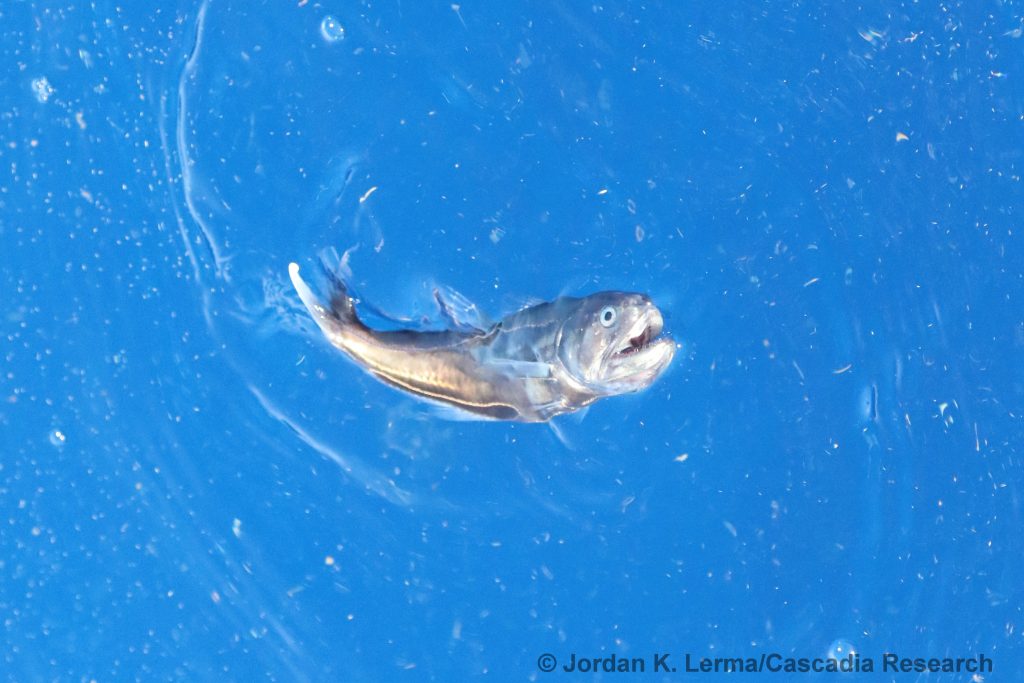
We also collected a small fish found at the surface far offshore, likely a myctophid
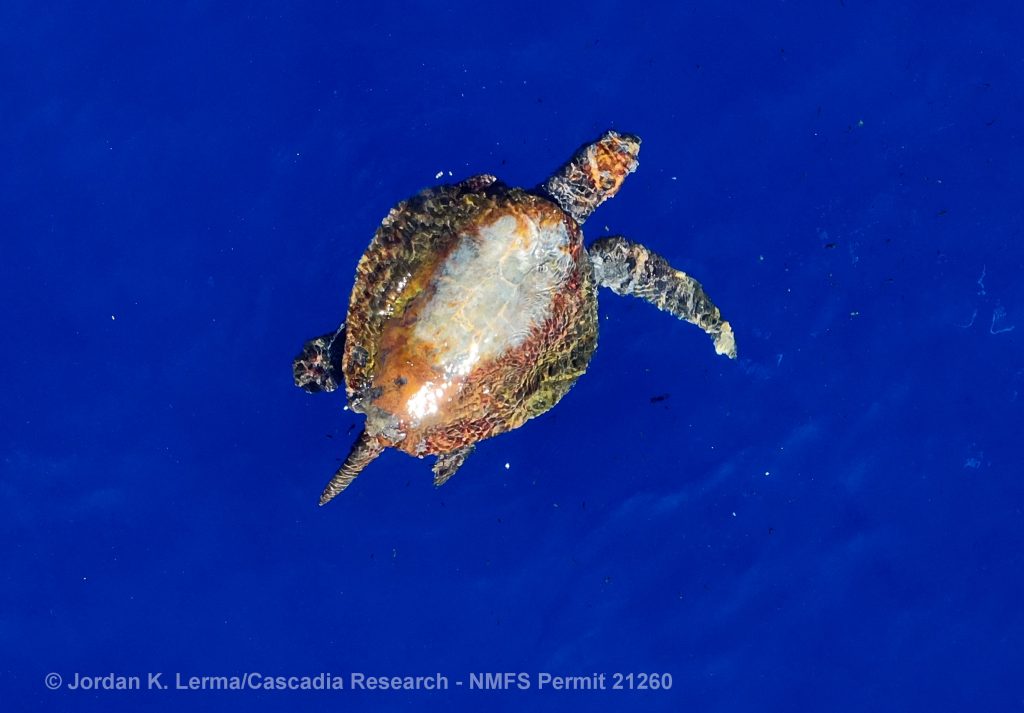
Our most unusual sighting of the last two days was an Olive Ridley sea turtle! Working under the Pacific Islands Fisheries Science Center sea turtle permit we were able to get drone photogrammetry images of this individual (an adult male based on the tail size), and with the drone also documented that it is missing the left front flipper.
October 15th update
Our first day on the water was quite productive, with seven encounters of four different species of cetaceans. The most unusual encounter was a mixed group of about 35 short-finned pilot whales and 140 melon-headed whales, with a lot of interactions between the two species. The photo below shows eight pilot whales (including the spyhopping individual) in front of a sub-group of about 25 melon-headed whales. We were able to obtain good underwater video footage of the interactions between the two species, and a couple of thousand photographs for individual identification.

We collected our first eDNA samples for the trip, one set of samples (10 x 1 liter bottles) from a group of pilot whales, and the other (14 x 1 liter bottles) from the mixed group of melon-headed whales and short-finned pilot whales.

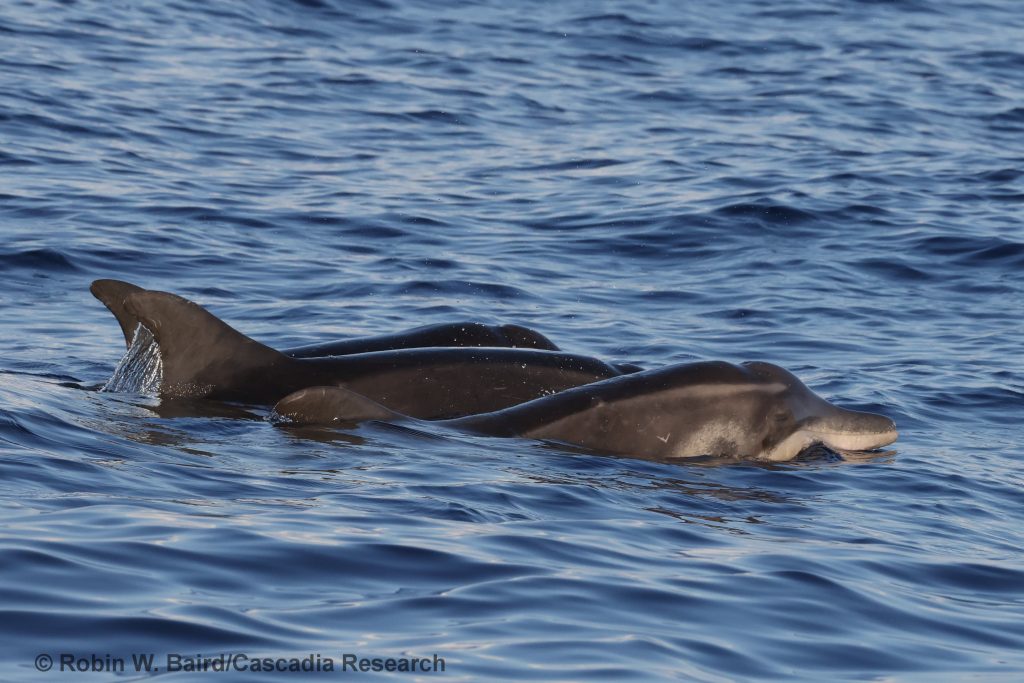
We encountered a group of about nine rough-toothed dolphins feeding in association with some floating debris, and were able to get good ID photos of the group as well as drone footage that we’ll use for both photogrammetry of the individuals (e.g., measuring total body length and examining body condition) as well as for documenting behavior.
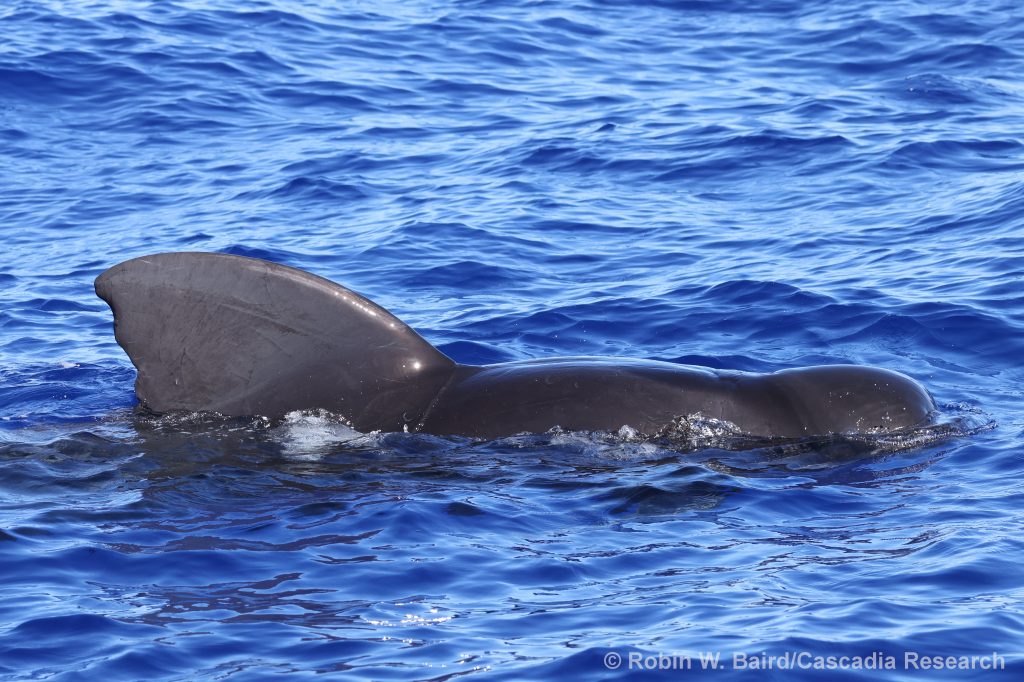
Photos on this page were taken under NMFS Scientific Research Permit No. 20605. Contact Robin Baird (rwbaird (at) cascadiaresearch (dot) org) for more information on this project.